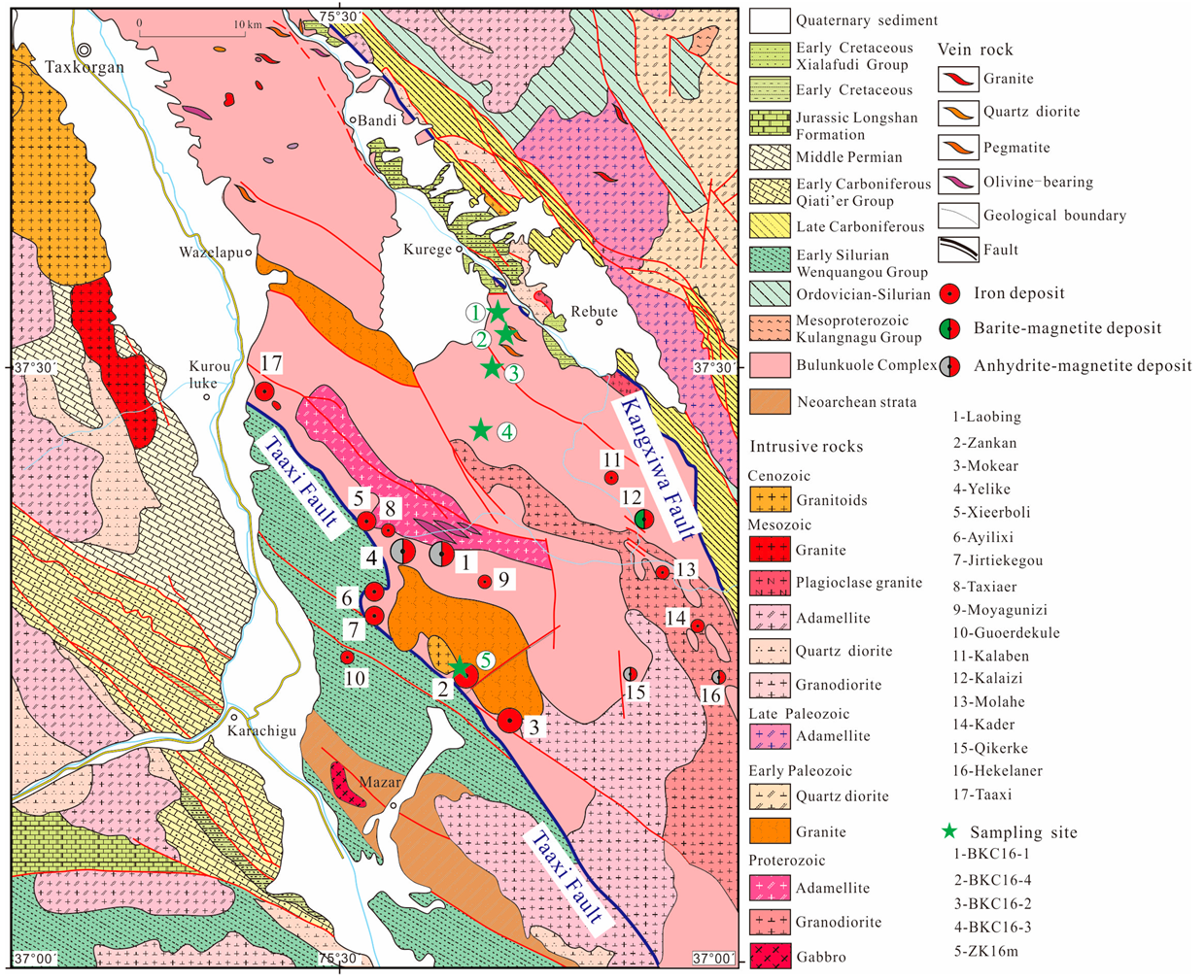The Redefinition of the “Bulunkuole Group” in the West Kunlun Orogenic Belt, Xinjiang (NW China): Implications for Tectonic Evolution of the Proto-Tethys
Abstract
1. Introduction
2. Geological Background
3. Samples and Methods
3.1. Sample Descriptions
3.2. Analytical Methods
3.2.1. Major and Trace Elements
3.2.2. Zircon U–Pb Dating
4. Results
4.1. Whole-Rock Geochemistry
4.2. Zircon U–Pb Ages
4.2.1. Ages of the Metavolcanic Rock
4.2.2. Ages of the Metasedimentary Rocks
4.2.3. Metamorphic Zircon U–Pb Ages
5. Discussion
5.1. Geochronology of the BKC
5.2. Provenance of the Metasedimentary Rocks of the BKC
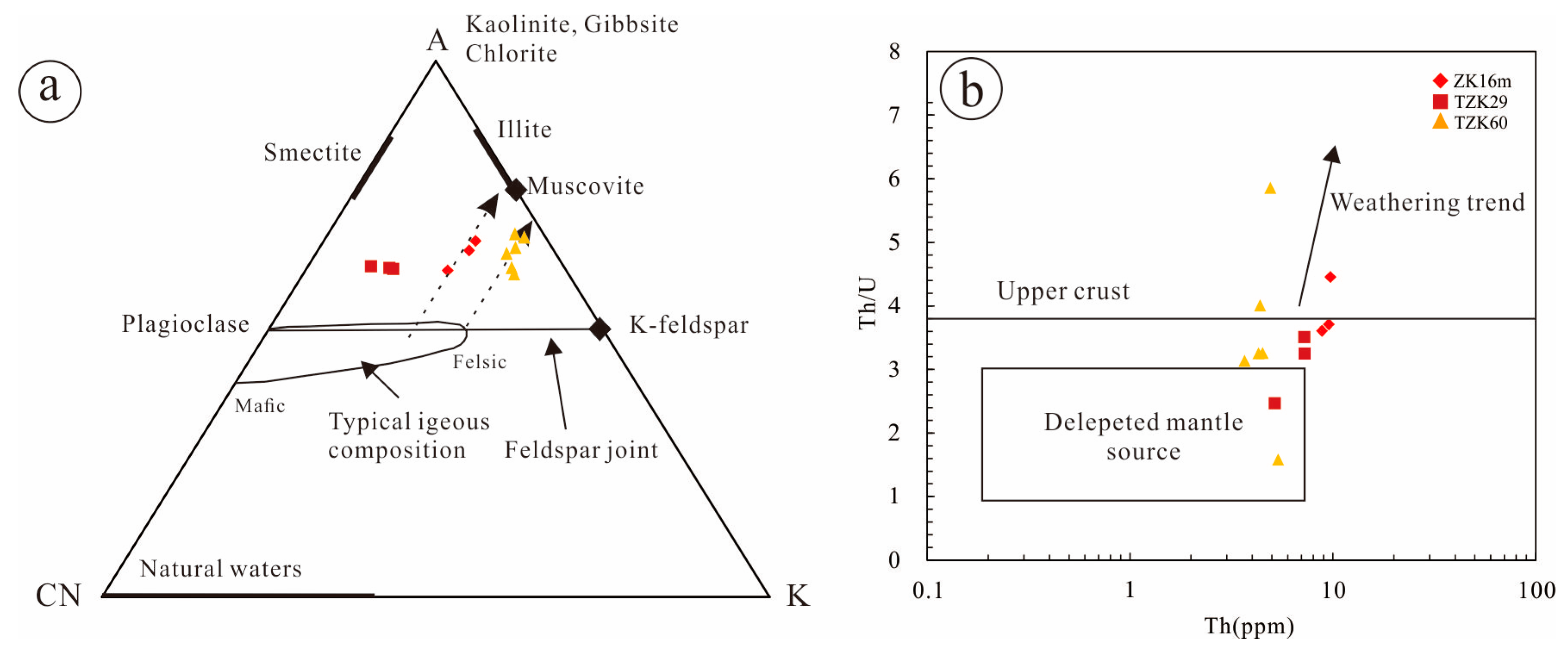
5.3. Implication for Tectonic Setting and Tectonic Evolution of the BKC
6. Conclusions
Supplementary Materials
Author Contributions
Funding
Data Availability Statement
Acknowledgments
Conflicts of Interest
References
- Zhang, C.L.; Zou, H.B.; Li, H.K.; Wang, H.Y. Tectonic framework and evolution of the Tarim Block in NW China. Gondwana Res. 2013, 23, 1306–1315. [Google Scholar] [CrossRef]
- Zhang, C.L.; Zou, H.B.; Ye, X.T.; Chen, X.Y. Tectonic evolution of the NE section of the Pamir Plateau: New evidence from field observations and zircon U-Pb geochronology. Tectonophysics 2018, 723, 27–40. [Google Scholar] [CrossRef]
- Li, S.Z.; Zhao, S.U.; Liu, X.; Cao, H.H.; Yu, S.; Li, X.Y.; Somerville, I.; Yu, S.Y.; Suo, Y.H. Closure of the Proto-Tethys Ocean and Early Paleozoic amalgamation of microcontinental blocks in East Asia. Earth Sci. Rev. 2018, 186, 37–75. [Google Scholar] [CrossRef]
- ŞEngör, A.M.C. The Palaeo-Tethyan suture: A line of demarcation between two fundamentally different architectural styles in the structure of Asia. Isl. Arc 1992, 1, 78–91. [Google Scholar] [CrossRef]
- Tapponnier, P.; Peltzer, G.; Armijo, R. On the mechanics of the collision between India and Asia. Geo. Soc. Lond. Spec. Pub. 1986, 19, 113–157. [Google Scholar] [CrossRef]
- Ducea, M.N.; Lutkov, V.; Minaev, V.T.; Hacker, B.R. Building the Pamirs: The view from the underside. Geology 2003, 31, 849. [Google Scholar] [CrossRef]
- Li, S.Z.; Zhao, S.J.; Li, X.Y.; Cao, H.H.; Liu, X.; Guo, X.Y.; Xiao, W.J.; Lai, S.C.; Yan, Z.; Li, Z.H. Proto-Tethys Ocean in East Asia (I) Northern and southern border faults and subduction polarity. Acta Petrol. Sin. 2016, 32, 2609–2627, (In Chinese with English abstract). [Google Scholar]
- Li, S.Z.; Zhao, S.J.; Yu, S.; Cao, H.H.; Li, X.Y.; Liu, X.; Guo, X.Y.; Xiao, W.J.; Lai, S.C.; Yan, Z.; et al. Proto-Tehtys Ocean in East Asia (II): Affinity and assmbly of Early Paleozoic micro-continental blocks. Acta Petrol. Sin. 2016, 32, 2628–2644, (In Chinese with English abstract). [Google Scholar]
- Zhang, C.L.; Zou, H.B.; Ye, X.T.; Chen, X.Y. A newly identified Precambrian terrane at the Pamir Plateau: The Archean basement and Neoproterozoic granitic intrusions. Precambrian Res. 2018, 304, 73–87. [Google Scholar] [CrossRef]
- Zhu, D.C.; Zhao, Z.D.; Niu, Y.L.; Mo, X.X.; Chung, S.L.; Hou, Z.Q.; Wang, L.Q.; Wu, F.Y. The Lhasa Terrane: Record of a microcontinent and its histories of drift and growth. Earth Planet. Sci. Lett. 2011, 301, 241–255. [Google Scholar] [CrossRef]
- Zhu, D.C.; Zhao, Z.D.; Niu, Y.L.; Dilek, Y.; Mo, X.X. Lhasa terrane in southern Tibet came from Australia. Geology 2011, 39, 727–730. [Google Scholar] [CrossRef]
- Zhu, D.C.; Li, S.M.; Cawood, P.A.; Wang, Q.; Zhao, Z.D.; Liu, S.A.; Wang, L.Q. Assembly of the Lhasa and Qiangtang terranes in central Tibet by divergent double subduction. Lithos 2016, 245, 7–17. [Google Scholar] [CrossRef]
- Kroner, U.; Roscher, M.; Romer, R.L. Ancient plate kinematics derived from the deformation pattern of continental crust: Paleo-and Neo-Tethys opening coeval with prolonged Gondwana–Laurussia convergence. Tectonophysics 2016, 681, 220–233. [Google Scholar] [CrossRef]
- Zhang, K.J.; Zhang, Y.X.; Tang, X.C.; Xia, B. Late Mesozoic tectonic evolution and growth of the Tibetan plateau prior to the Indo-Asian collision. Earth Sci. Rev. 2012, 114, 236–249. [Google Scholar] [CrossRef]
- Zhang, J.X.; Yu, S.Y.; Mattinson, C.G. Early Paleozoic polyphase metamorphism in northern Tibet, China. Gondwana Res. 2017, 41, 267–289. [Google Scholar] [CrossRef]
- Zhang, C.L.; Zou, H.B.; Ye, X.T.; Chen, X.Y. Tectonic evolution of the West Kunlun Orogenic Belt along the northern margin of the Tibetan Plateau: Implications for the assembly of the Tarim terrane to Gondwana. Geosci. Front. 2019, 10, 973–988. [Google Scholar] [CrossRef]
- Zhang, C.L.; Ma, D.H.; Zhu, B.Y.; Ye, X.T.; Qiu, L.; Zhao, H.X.; Liu, X.Q.; Ding, T.; Wang, Q.; Hao, X.S. Tectonic evolution of the Western Kunlun-Karakorum Orogenic Belt and its coupling with the mineralization effect. Geo. Rev. 2019, 65, 1077–1102, (In Chinese with English abstract). [Google Scholar]
- Bureau of Geology and Mineral Resources of Xinjiang Uygur Autonomous Region. Regional Geology of Xinjiang Uygur Autonomous Region; Geological Publishing House Beijing: Beijing, China, 1993. (In Chinese) [Google Scholar]
- Zhou, Z.J.; Tang, H.S.; Chen, Y.J.; Chen, Z.L. Trace elements of magnetite and iron isotopes of the Zankan iron deposit, westernmost Kunlun, China: A case study of seafloor hydrothermal iron deposits. Ore Geol. Rev. 2017, 80, 1191–1205. [Google Scholar] [CrossRef]
- Li, Z.Q.; Zhang, L.C.; Xue, C.J.; Zhu, M.T.; Zheng, M.T.; Robbins, L.J.; Konhauser, K.O. Genesis of the Neoproterozoic-Early Cambrian banded iron ore-bearing sedimentary rocks in the Jiertieke-Zankan iron ore belt, West Kunlun Orogenic Belt, Xinjiang (NW China). J. Asian Earth Sci. 2019, 173, 143–160. [Google Scholar] [CrossRef]
- Peng, Z.D.; Zheng, M.T.; Wang, C.L.; Zhang, L.C.; Fan, L.G.; Tong, X.X. Constraints on the age and geodynamic setting of the iron formations and anhydrite Fe-(Ba) deposits in the Bulunkuole Group of the Taxkorgan area, NW China. Ore Geol. Rev. 2021, 133. [Google Scholar] [CrossRef]
- Ding, T.; Tan, T.T.; Wang, J.; Zhang, C.L.; Ye, X.T.; Liang, J.; Hao, X.S.; Wu, B. Field and zircon U–Pb geochronological evidence for the occurrence of Cambrian banded iron formations in the West Kunlun Orogenic Belt, China. Gondwana Res. 2021, 98, 1–16. [Google Scholar] [CrossRef]
- Zheng, M.T.; Wang, C.L.; Zhang, L.C.; Shi, Z.B.; Zhu, M.T.; Li, Z.Q.; He, L.D. Geological and geochemical constraints on the origin of the Early Cambrian Kalaizi Fe–Ba deposit in Western Kunlun, NW China. Ore Geol. Rev. 2018, 100, 347–359. [Google Scholar] [CrossRef]
- Şengör, A.; Natal’In, B.; Burtman, V. Evolution of the Altaid tectonic collage and Palaeozoic crustal growth in Eurasia. Nature 1993, 364, 299–307. [Google Scholar] [CrossRef]
- ŞEngör, A.M.C. Paleotectonics of Asia: Fragments of a synthesis. In The Tectonic Evolution of Asia; Cambridge University Press: Cambridge, UK, 1996; pp. 486–640. [Google Scholar]
- Zhang, C.L.; Zou, H.B.; Ye, X.T.; Chen, X.Y. Timing of subduction initiation in the Proto-Tethys Ocean: Evidence from the Cambrian gabbros from the NE Pamir Plateau. Lithos 2018, 314–315, 40–51. [Google Scholar] [CrossRef]
- Sun, H.T.; Li, C.J.; Wu, H.; Wang, H.J.; Qi, S.J.; Chen, G.M.; Liu, Z.T.; Gao, P. Overview of Metallogenesis on Western Kunlun; Geological Publishing House: Beijing, China, 2003; 251p. (In Chinese) [Google Scholar]
- Zhang, C.L.; Lu, S.N.; Yu, H.F.; Ye, H.M. Tectonic evolution of the Western Kunlun orogenic belt in northern Qinghai-Tibet Plateau: Evidence from zircon SHRIMP and LA-ICP-MS U-Pb geochronology. Sci. China Ser. D 2007, 50, 825–835, (In Chinese with English abstract). [Google Scholar] [CrossRef]
- Wang, J.P. Geological features and tectonic significance of melange zone in the Taxkorgan area, West Kunlun. Geol. Bull. China 2008, 27, 2057–2066. [Google Scholar]
- Ji, W.H.; Li, R.S.; Chen, S.J.; He, S.P.; Zhao, Z.M.; Bian, X.W.; Zhu, H.P.; Cui, J.G.; Ren, J.G. The discovery of Palaeoproterozoic volcanic rocks in the Bulunkuoler Group from the Tianshuihai Massif in Xinjiang of Northwest China and its geological significance. Sci. China. Earth. Sci. 2011, 41, 1268–1280, (In Chinese with English abstract). [Google Scholar] [CrossRef]
- Yan, C.H.; Chen, C.J.; Cao, X.Z.; Zhang, W.S.; Chen, J.K.; Li, S.P.; Liu, P.D. The discovery of the “Pamir-type” iron deposits in Taxkorgan area of Xinjiang and its geological significance. Geol. Bull. China 2012, 31, 549–557, (In Chinese with English abstract). [Google Scholar]
- Yang, W.Q. The Indosinian Metamorphism, Magmatism and Formation Age of Bunlunkuole Rock Group in Taxkorgan-Kangxiwar Tectonic Belt, Western Kunlun. Ph.D. Thesis, Northwest University: Xi’an, China, 2013; pp. 1–128, (In Chinese with English abstract). [Google Scholar]
- Feng, C.R. Geological Features, Mineralization Model and Prospecting of Iron Deposits in Taxkorgan Region, West Kunlun Mountains. Ph.D. Thesis, China University of Geosciences, Beijing, China, 2013; pp. 1–159, (In Chinese with English abstract). [Google Scholar]
- Xiao, P.X.; Gao, X.F.; Kang, L.; Xie, C.R. Redefinition and significance of “Bulunkuole Group” in Taxkorgan region, Xinjiang. Annual Meeting of Chinese Geoscience Union, 2014. Earth Planet. Phys. 2014, 5, 1–121. (In Chinese) [Google Scholar]
- Huang, C.Y. Geological Characteristics and Genesis of the Iron Ore Deposit in the Bulunkuole Group, West Kunlun, Xinjiang. Ph.D. Thesis, Guangzhou Institute of Geochemistry Chinese Academy of Sciences, Guangzhou, China, 2014; pp. 1–83, (In Chinese with English abstract). [Google Scholar]
- Li, H.Z.; Zhai, M.G.; Zhang, L.C.; Li, Z.Q.; Zheng, M.T.; Niu, J.; Yu, P.P. Study on geochemistry and micro-area characteristics of Paleoproterozoic chemical sedimentary rocks from Zankan area, West Kunlun, China. Acta Petrol. Sin. 2016, 32, 233–250, (In Chinese with English abstract). [Google Scholar]
- Zhang, L.C.; Feng, J.; Dong, L.H.; Zhu, M.T.; Zheng, M.T.; Li, Z.Q.; Hao, Y.H.; Shi, Y.J. Deposit types, origin and metallogenetic regularity of Taxkorgan Iron Ore Belt in West Kunlun. J. Earth Sci. Environ. 2016, 38, 427–443, (In Chinese with English abstract). [Google Scholar]
- Zheng, M.T.; Zhang, L.C.; Shu, M.T.; Li, Z.Q. Geological characteristics, formation age and genesis of the Kalaizi Ba-Fe deposit in West Kunlun. Earth Sci. Front. 2016, 23, 252, (In Chinese with English abstract). [Google Scholar]
- Chen, J.K. Formation Age of Ore-bearing Strata from the Laobing Iron Deposit in Taxkorgan area of Western Kunlun, Xinjiang and Its GeologicalSignificance. Northwes. Geol. 2018, 51, 105–120, (In Chinese with English abstract). [Google Scholar]
- He, C.G.; Wang, S.Y.; Fang, H.B.; Chai, J.Y.; Su, J.C.; Chang, Y.W.; Wang, L.L.; Chen, D.H. Redefination and ore-forming significance of Maeryang Forming, Taxkorgan, Western Kunlun Mountains. Geo China 2019, 46, 517–536, (In Chinese with English abstract). [Google Scholar]
- Zhang, H.S.; Ji, W.H.; Ma, Z.P.; Gao, X.F.; Sun, C.; Hong, J.; Lv, P.R. Geochronology and geochemical study of the Cambrian andesite in Tianshuihai Terrane: Implications for the evolution of the Proto-Tethys Ocean in the West Kunlun-Karakoram Orogenic Belt. Acta Petrol. Sin. 2020, 36, 257–278, (In Chinese with English abstract). [Google Scholar]
- Hu, J.; Huang, C.Y.; Wang, H. U-Pb zircon geochronology and geochemistry of metavolcanics and associated iron ores of the magnetite-rich BIF deposits in the Western Kunlun orogenic belt: Constraints on the depositional age, origin and tectonic setting. Ore Geol. Rev. 2020, 126, 103751. [Google Scholar] [CrossRef]
- Yang, W.Q.; Liu, L.; Cao, Y.T.; Wang, C.; He, S.P.; Li, R.S.; Zhu, X.H. Geochronological evidence of Indosinian (high-pressure) metamorphic event and its tectonic significance in Taxkorgan area of the Western Kunlun Mountains, NW China. Sci. China Earth Sci. 2010, 53, 1445–1459. [Google Scholar] [CrossRef]
- Xiao, W.J.; Windley, B.F.; Liu, D.Y.; Jian, P.; Liu, C.Z.; Yuan, C.; Sun, M. Accretionary Tectonics of the Western Kunlun Orogen, China: A Paleozoic–Early Mesozoic, Long-Lived Active Continental Margin with Implications for the Growth of Southern Eurasia. J. Geol. 2005, 113, 687–705. [Google Scholar] [CrossRef]
- Dong, L.H.; Li, J.H.; Feng, J.; Zhuang, D.Z.; Liu, B.; Li, F.M.; Qu, X.; Jiang, Y.H. The main Achievement and progress of Xinjiang Geology and Mineral Exploration in 2011. Xinjiang Geol. 2012, 30, 1–4, (In Chinese with English abstract). [Google Scholar]
- Wang, Y.Z. Geological Map of Western South of Xinjiang at the Scale of 1: 500,000, Mineral Chart Manual. No.2 Geological Party of Xinjiang Bureau of Geological and Mineral Resource; China University of Geosciences Press: Beijing China, 1985. (In Chinese) [Google Scholar]
- Zhu, G.; Liu, W.; Wu, G.; Ma, B.; Nance, R.D.; Wang, Z.; Xiao, Y.; Chen, Z. Geochemistry and U-Pb-Hf detrital zircon geochronology of metamorphic rocks in terranes of the West Kunlun Orogen: Protracted subduction in the northernmost Proto-Tethys Ocean. Precambrian Res. 2021, 363, 106344. [Google Scholar] [CrossRef]
- Wang, S.Y.; Peng, S.M.; Ma, R.S.; Zhang, Y.; Lv, J.G.; Bai, G.D.; Xie, C.Y.; Gao, T.; Ren, J.D.; Liu, P.D.; et al. The People’s Republic of China Regional Geological Report: Kuketuluke Map (J43C003002), Taxkorgan Map (J43C003003): Scale 1: 250000; China Geological Survey: Beijing, China, 2014. [Google Scholar]
- Zhou, Z.J.; Tang, H.S.; Wu, Y.S.; Li, Q.G.; Chen, Y.J.; Chen, Z.L. Geology, geochemistry and genesis of the Zankan iron deposit in the West Kunlun Orogen, Xinjiang, China. Ore Geol. Rev. 2018, 100, 334–346. [Google Scholar] [CrossRef]
- Qi, L.; Zhou, M.F.; Gao, J.f.; Zhao, Z. An improved Carius tube technique for determination of low concentrations of Re and Os in pyrites. J. Anal. At. Spectrom. 2010, 25, 585–589. [Google Scholar] [CrossRef]
- Liu, Y.S.; Hu, Z.C.; Gao, S.; Günther, D.; Xu, J.; Gao, C.G.; Chen, H.H. In situ analysis of major and trace elements of anhydrous minerals by LA-ICP-MS without applying an internal standard. Chem. Geol. 2008, 257, 34–43. [Google Scholar] [CrossRef]
- Liu, Y.S.; Hu, Z.C.; Zong, K.Q.; Gao, C.G.; Gao, S.; Xu, J.A.; Chen, H.H. Reappraisement and refinement of zircon U-Pb isotope and trace element analyses by LA-ICP-MS. Chin. Sci. Bull. 2010, 55, 1535–1546. [Google Scholar] [CrossRef]
- Ludwig, K.R. User’s manual for isoplot 3.00, a geochronlogical toolkit for microsoft excel. Berkeley Geochronl. Cent. Spec. Publ. 2003, 4, 25–32. [Google Scholar]
- Rudnick, R.L.; Gao, S. 3.01-Composition of the Continental Crust. In Treatise on Geochemistry; Holland, H.D., Turekian, K.K., Eds.; Pergamon: Oxford, UK, 2003; pp. 1–64. [Google Scholar]
- Roser, B.P.; Cooper, R.A.; Nathan, S.; Tulloch, A.J. Reconnaissance sandstone geochemistry, provenance, and tectonic setting of the lower Paleozoic terranes of the West Coast and Nelson, New Zealand. N. Z. J. Geol. Geophys. 1996, 39, 1–16. [Google Scholar] [CrossRef]
- Qiu, J.X.; Lin, J.Q. Lithochemistry; Geological Publishing House: Beijing China, 1991. (In Chinese) [Google Scholar]
- Herron, M.M. Geochemical classification of terrigenous sands and shales from core or log data. J. Sediment. Res. 1988, 58, 820–829. [Google Scholar]
- Wang, C.; Zhang, L.; Dai, Y.; Lan, C. Geochronological and geochemical constraints on the origin of clastic meta-sedimentary rocks associated with the Yuanjiacun BIF from the Lüliang Complex, North China. Lithos 2015, 212–215, 231–246. [Google Scholar] [CrossRef]
- Tao, H.; Sun, S.; Wang, Q.; Yang, X.; Jiang, L. Petrography and geochemistry of lower carboniferous greywacke and mudstones in Northeast Junggar, China: Implications for provenance, source weathering, and tectonic setting. J. Asian Earth Sci. 2014, 87, 11–25. [Google Scholar] [CrossRef]
- Wang, C.; Huang, H.; Tong, X.; Zheng, M.; Peng, Z.; Nan, J.; Zhang, L.; Zhai, M. Changing provenance of late Neoarchean metasedimentary rocks in the Anshan-Benxi area, North China Craton: Implications for the tectonic setting of the world-class Dataigou banded iron formation. Gondwana Res. 2016, 40, 107–123. [Google Scholar] [CrossRef]
- Hu, J.; Wang, H.; Wang, M. Provenance and tectonic setting of siliciclastic rocks associated with the Neoproterozoic Dahongliutan BIF: Implications for the Precambrian crustal evolution of the Western Kunlun orogenic belt, NW China. J. Asian Earth Sci. 2017, 147, 95–115. [Google Scholar] [CrossRef]
- Boynton, W.V. Chapter 3-Cosmochemistry of the Rare Earth Elements: Meteorite Studies. In Developments in Geochemistry; Henderson, P., Ed.; Elsevier: Amsterdam, The Netherlands, 1984; Volume 2, pp. 63–114. [Google Scholar]
- Hoskin, P.W.; Schaltegger, U. The composition of zircon and igneous and metamorphic petrogenesis. Rev. Mineral. Geochem. 2003, 53, 27–62. [Google Scholar] [CrossRef]
- Cui, J.T.; Bian, X.W.; Wang, G.B. Geological composition and evolution of the western Kunlun. Geol. Shanxi 2006, 24, 1–11, (In Chinese with English abstract). [Google Scholar]
- Li, Z.Q.; Zhang, L.C.; Xue, C.J.; Zheng, M.T.; Hao, Y.H.; Shi, Y.J. Geological and geochemical characteristics of Zankan iron deposit in the West Kunlun Mountains. Chin. J. Geol. 2015, 50, 100–117, (In Chinese with English abstract). [Google Scholar]
- Lin, S.K. Study on Geochemistry and Zircon U-Pb Ages of Dacite Porphyry from the Zankan Iron Deposit West Kunlun Area. Master’s Thesis, The Kunming Universty of Science and Technology, Kunming, China, 2015; pp. 1–64, (In Chinese with English abstract). [Google Scholar]
- Babinski, M.; Boggiani, P.C.; Trindade, R.I.F.; Fanning, C.M. Detrital zircon ages and geochronological constraints on the Neoproterozoic Puga diamictites and associated BIFs in the southern Paraguay Belt, Brazil. Gondwana Res. 2013, 23, 988–997. [Google Scholar] [CrossRef]
- Liu, W.P.; He, W.; Tong, L.X.; Wu, Y.F.; Huang, C.Y.; Hu, J. Geochemical characteristics and metamorphic PT paths of the Bulunkuole Group in Taxkorgan, western Kunlun. Acta Petrol. Sin. 2013, 29, 923–937, (In Chinese with English abstract). [Google Scholar]
- Qu, J.; Zhang, L.; Ai, Y.; Lü, Z.; Wang, J.; Zhou, H.; Wang, S. High-pressure granulite from Western Kunlun, northwestern China: Its metamorphic evolution, zircon SHRIMP U-Pb ages and tectonic implication. Sci. China Ser. D 2007, 50, 961–971. [Google Scholar] [CrossRef]
- Jiang, Y.H.; Jiang, S.Y.; Ling, H.F.; Zhou, X.R.; Rui, X.J.; Yang, W.Z. Petrology and geochemistry of shoshonitic plutons from the western Kunlun orogenic belt, Xinjiang, northwestern China: Implications for granitoid geneses. Lithos 2002, 63, 165–187. [Google Scholar] [CrossRef]
- Ji, W.H.; Han, F.L.; Wang, J.C.; Zhang, J.L. Compositon and geochemistry of the Subashi ophiolitic mélange in the West Kunlun and its geological significance. Geol. Bull. China 2004, 23, 1196–1201, (In Chinese with English abstract). [Google Scholar]
- Qu, J.F.; Zhang, L.F.; Zhang, J.; Zhang, B. Petrology and geochronology on high-pressure pelitic granulite from Bulunkuole complex in West Kunlun and its tectonic implication. Acta Petrol. Sin. 2021, 37, 563–574, (In Chinese with English abstract). [Google Scholar]
- Robinson, A.C.; Ducea, M.; Lapen, T.J. Detrital zircon and isotopic constraints on the crustal architecture and tectonic evolution of the northeastern Pamir. Tectonics 2012, 31, 1–16. [Google Scholar] [CrossRef]
- Rollinson, H.R. Using Geochemical Data: Evaluation, Presentation, Interpretation; Routledge: Abingdon, UK, 2014. [Google Scholar]
- Taylor, S.R.; McLennan, S.M. The Continental Crust: Its Composition and Evolution: An Examination of the Geochemical Record Preserved in Sedimentary Rocks; Blackwell Scientific Publications: Hoboken, NJ, USA, 1985. [Google Scholar]
- Mclennan, S.M. Rare earth elements in sedimentary rocks: Influence of provenance and sedimentary processes. Geochem. Mineral. Rare Earth Elem. 2018, 21, 169–200. [Google Scholar]
- Pearce, J.A. A user’s guide to basalt discrimination diagrams. In Trace Element Geochemistry of Volcanic Rocks: Applications for Massive Sulphide Exploration; Short Course Notes; Geological Association of Canada: St. John’s, NL, Canada, 1996; Volume 12, p. 113. [Google Scholar]
- Cox, R.; Lowe, D.R.; Cullers, R.L. The influence of sediment recycling and basement composition on evolution of mudrock chemistry in the southwestern United States. Geochim. Cosmochim. Acta 1995, 59, 2919–2940. [Google Scholar] [CrossRef]
- van de Kamp, P.C.; Leake, B.E. Petrography and geochemistry of feldspathic and mafic sediments of the northeastern Pacific margin. Earth Environ. Sci. Trans. R. Soc. Edinb. 1985, 76, 411–449. [Google Scholar] [CrossRef]
- Nesbitt, H.W.; Young, G.M. Early Proterozoic climates and plate motions inferred from major element chemistry of lutites. Nature 1982, 299, 715–717. [Google Scholar] [CrossRef]
- McLennan, S.M. Weathering and Global Denudation. J. Geol. 1993, 101, 295–303. [Google Scholar] [CrossRef]
- Bauluz, B.; Mayayo, M.J.; Fernandez-Nieto, C.; Gonzalez Lopez, J.M. Geochemistry of Precambrian and Paleozoic siliciclastic rocks from the Iberian Range (NE Spain): Implications for source-area weathering, sorting, provenance, and tectonic setting. Chem. Geol. 2000, 168, 135–150. [Google Scholar] [CrossRef]
- Fedo, C.M.; Wayne Nesbitt, H.; Young, G.M. Unraveling the effects of potassium metasomatism in sedimentary rocks and paleosols, with implications for paleoweathering conditions and provenance. Geology 1995, 23, 921–924. [Google Scholar] [CrossRef]
- Partin, C.A.; Bekker, A.; Planavsky, N.J.; Scott, C.T.; Gill, B.C.; Li, C.; Podkovyrov, V.; Maslov, A.; Konhauser, K.O.; Lalonde, S.V.; et al. Large-scale fluctuations in Precambrian atmospheric and oceanic oxygen levels from the record of U in shales. Earth Planet. Sci. Lett. 2013, 369–370, 284–293. [Google Scholar] [CrossRef]
- McLennan, S.; Hemming, S.; Taylor, S.; Eriksson, K. Early Proterozoic crustal evolution: Geochemical and NdPb isotopic evidence from metasedimentary rocks, southwestern North America. Geochim. Cosmochim. Acta 1995, 59, 1153–1177. [Google Scholar] [CrossRef]
- Nesbitt, H.; Young, G.M. Formation and diagenesis of weathering profiles. J. Geol. 1989, 97, 129–147. [Google Scholar] [CrossRef]
- Gu, X.X.; Liu, J.M.; Zheng, M.H.; Tang, J.X.; Qi, L. Provenance and Tectonic Setting of the Proterozoic Turbidites in Hunan, South China: Geochemical Evidence. J. Sediment. Res. 2002, 72, 393–407. [Google Scholar] [CrossRef]
- Hayashi, K.-I.; Fujisawa, H.; Holland, H.D.; Ohmoto, H. Geochemistry of ∼1.9 Ga sedimentary rocks from northeastern Labrador, Canada. Geochim. Cosmochim. Acta 1997, 61, 4115–4137. [Google Scholar] [CrossRef] [PubMed]
- Girty, G.H.; Ridge, D.L.; Knaack, C.; Johnson, D.; Al-Riyami, R.K. Provenance and depositional setting of Paleozoic chert and argillite, Sierra Nevada, California. J. Sediment. Res. 1996, 66, 107–118. [Google Scholar] [CrossRef]
- Floyd, P.A.; Leveridge, B.E. Tectonic environment of the Devonian Gramscatho basin, south Cornwall: Framework mode and geochemical evidence from turbiditic sandstones. J. Geo. Soc. Lond. 1987, 144, 531–542. [Google Scholar] [CrossRef]
- Roser, B.P.; Korsch, R.J. Provenance signatures of sandstone-mudstone suites determined using discriminant function analysis of major-element data. Chem. Geol. 1988, 67, 119–139. [Google Scholar] [CrossRef]
- Cullers, R.L.; Bock, B.; Guidotti, C. Elemental distributions and neodymium isotopic compositions of Silurian metasediments, western Maine, USA: Redistribution of the rare earth elements. Geochim. Cosmochim. Acta. 1997, 61, 1847–1861. [Google Scholar] [CrossRef]
- Fedo, C.M.; Sircombe, K.N.; Rainbird, R.H. Detrital Zircon Analysis of the Sedimentary Record. Rev. Mineral. Geochem. 2003, 53, 277–303. [Google Scholar] [CrossRef]
- Hu, J.; Wang, H.; Huang, C.Y.; Tong, L.X.; Mu, S.L.; Qiu, Z.W. Geological characteristics and age of the Dahongliutan Fe-ore deposit in the Western Kunlun orogenic belt, Xinjiang, northwestern China. J. Asian Earth Sci. 2016, 116, 1–25. [Google Scholar] [CrossRef]
- Gao, X.F.; Xiao, P.X.; Kang, L.; Zhu, H.P.; Guo, L.; Xi, R.G.; Dong, Z. Origin of the Volcanic Rocks from the Ta’axi Region, Taxkorgan Xinjiang and Its Geological Significance. Earth Sci. 2013, 38, 1169–1182, (In Chinese with English abstract). [Google Scholar]
- Bhatia, M.R.; Crook, K.A. Trace element characteristics of graywackes and tectonic setting discrimination of sedimentary basins. Contrib. Mineral. Petrol. 1986, 92, 181–193. [Google Scholar] [CrossRef]
- McLennan, S.M.; Taylor, S.R.; McCulloch, M.T.; Maynard, J.B. Geochemical and Nd Sr isotopic composition of deep-sea turbidites: Crustal evolution and plate tectonic associations. Geochim. Cosmochim. Acta 1990, 54, 2015–2050. [Google Scholar] [CrossRef]
- Bhatia, M.R. Plate Tectonics and Geochemical Composition of Sandstones. J. Geol. 1983, 91, 611–627. [Google Scholar] [CrossRef]
- Bhatia, M.R. Rare earth element geochemistry of Australian Paleozoic graywackes and mudrocks: Provenance and tectonic control. Sediment. Geol. 1985, 45, 97–113. [Google Scholar] [CrossRef]
- Frisch, W.; Meschede, M.; Blakey, R. Contractional theory, continental drift and plate tectonics. In Plate Tectonics: Continental Drift and Mountain Building; Frisch, W., Meschede, M., Blakey, R.C., Eds.; Springer: Berlin/Heidelberg, Germany, 2011; pp. 1–13. [Google Scholar]
- Liu, C.J. Composition and Tectonic Evolution of West Kunlun Orogenic Belt and Its Periphery in the Early Paleozoic-Early Mesozoic; Chang’an University: Xi’an, China, 2015; (In Chinese with English abstract). [Google Scholar]
- Liu, Z.; Jiang, Y.H.; Jia, R.Y.; Zhao, P.; Zhou, Q.; Wang, G.C.; Ni, C.Y. Origin of Middle Cambrian and Late Silurian potassic granitoids from the western Kunlun orogen, northwest China: A magmatic response to the Proto-Tethys evolution. Mineral. Petrol. 2014, 108, 91–110. [Google Scholar] [CrossRef]
- Cui, J.T.; Wang, J.C.; Bian, X.W.; Zhu, H.P.; Yang, K.J. Geological characteristics of Early Paleozoic amphibolite and tonalite in northern Kangxiwar, West Kunlun, China and their zircon SHRIMP U-Pb dating. Geol. Bull. China 2006, 25, 1441–1449, (In Chinese with English abstract). [Google Scholar]
- Liu, X.Q.; Zhang, C.L.; Zou, H.; Ye, X.T. Diverse metavolcanic sequences in the Cambrian accretionary complex at the Pamir Syntax: Implications for tectonic evolution from Proto-Tethys to Paleo-Tethys. J. Asian Earth Sci. 2023, 241, 105481. [Google Scholar] [CrossRef]
- Ding, D.G.; Wang, D.X.; Liu, W.X.; Sun, S. The Western Kunlun Orogenic Belt and Basin; Geological Publishing House: Beijing, China, 1996; Volume 36, pp. 1–224. (In Chinese) [Google Scholar]
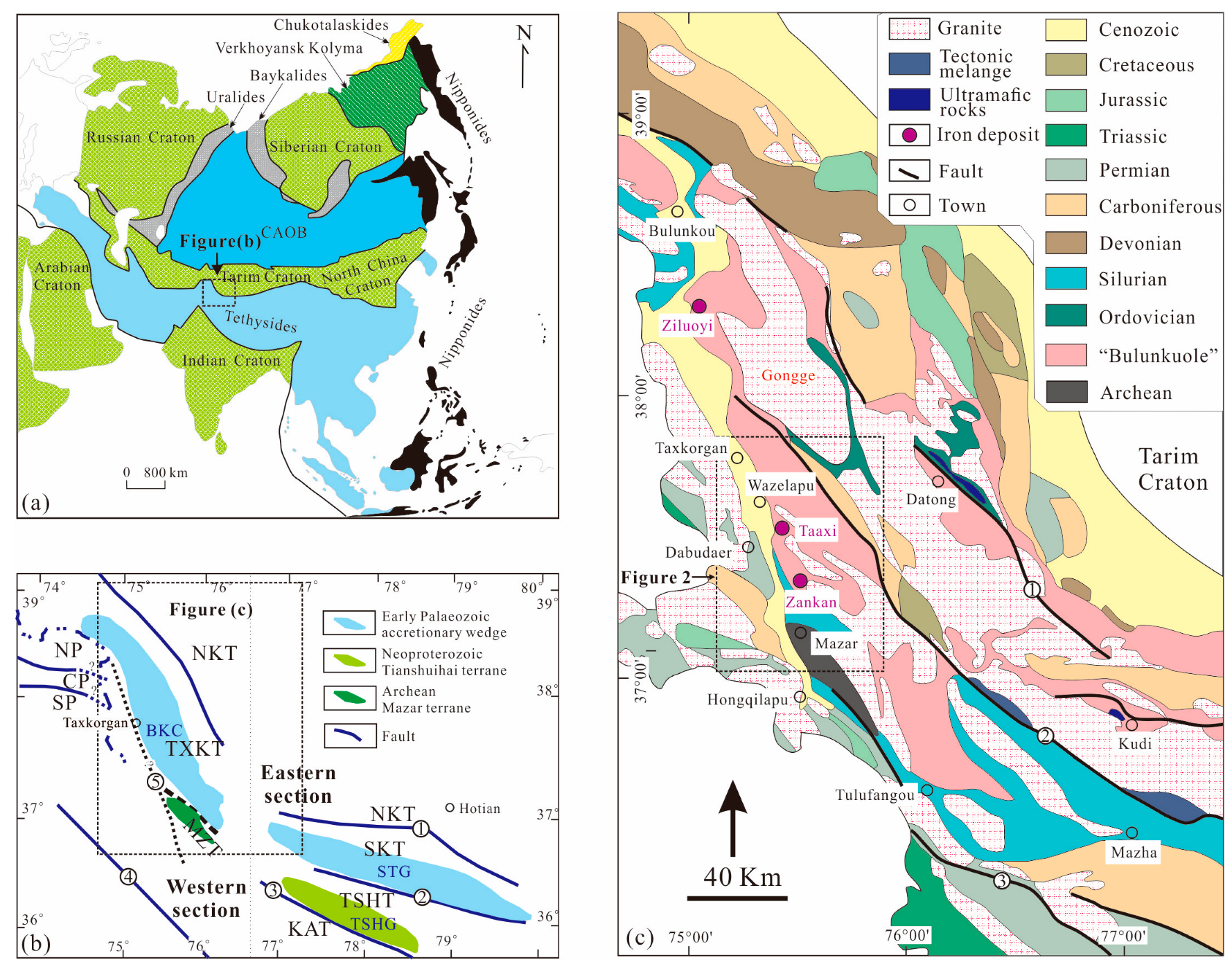
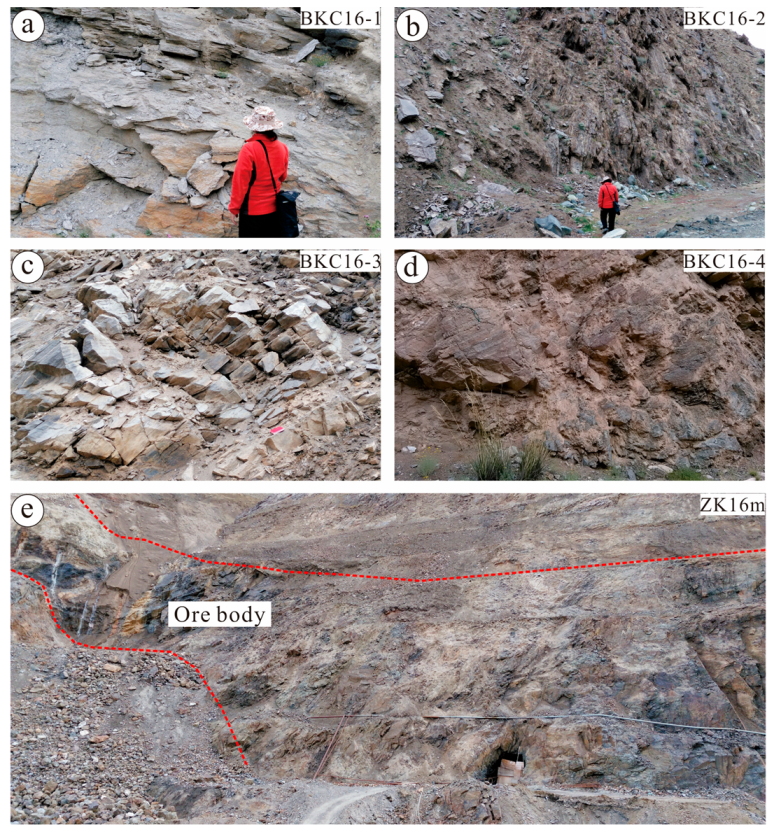
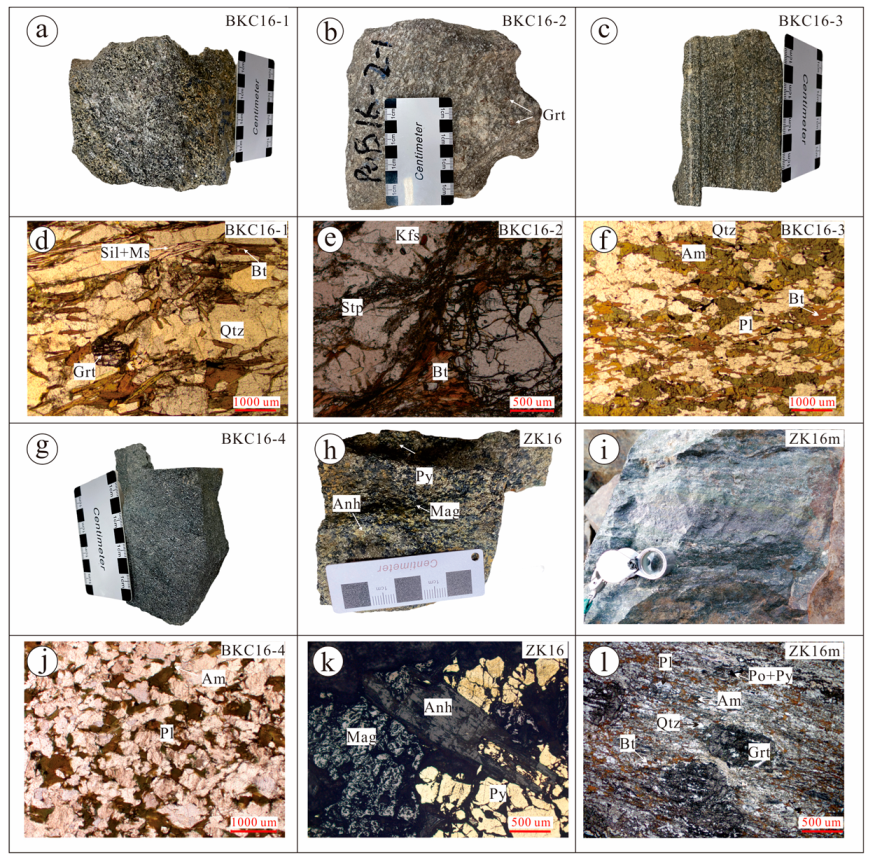
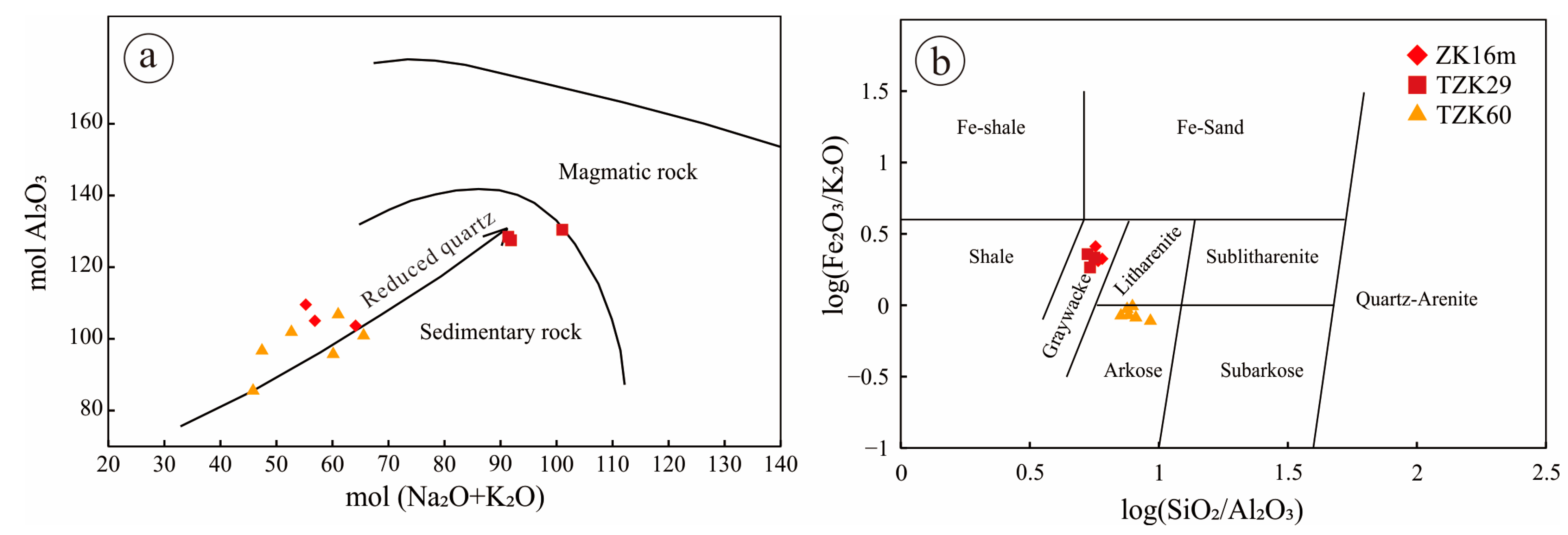
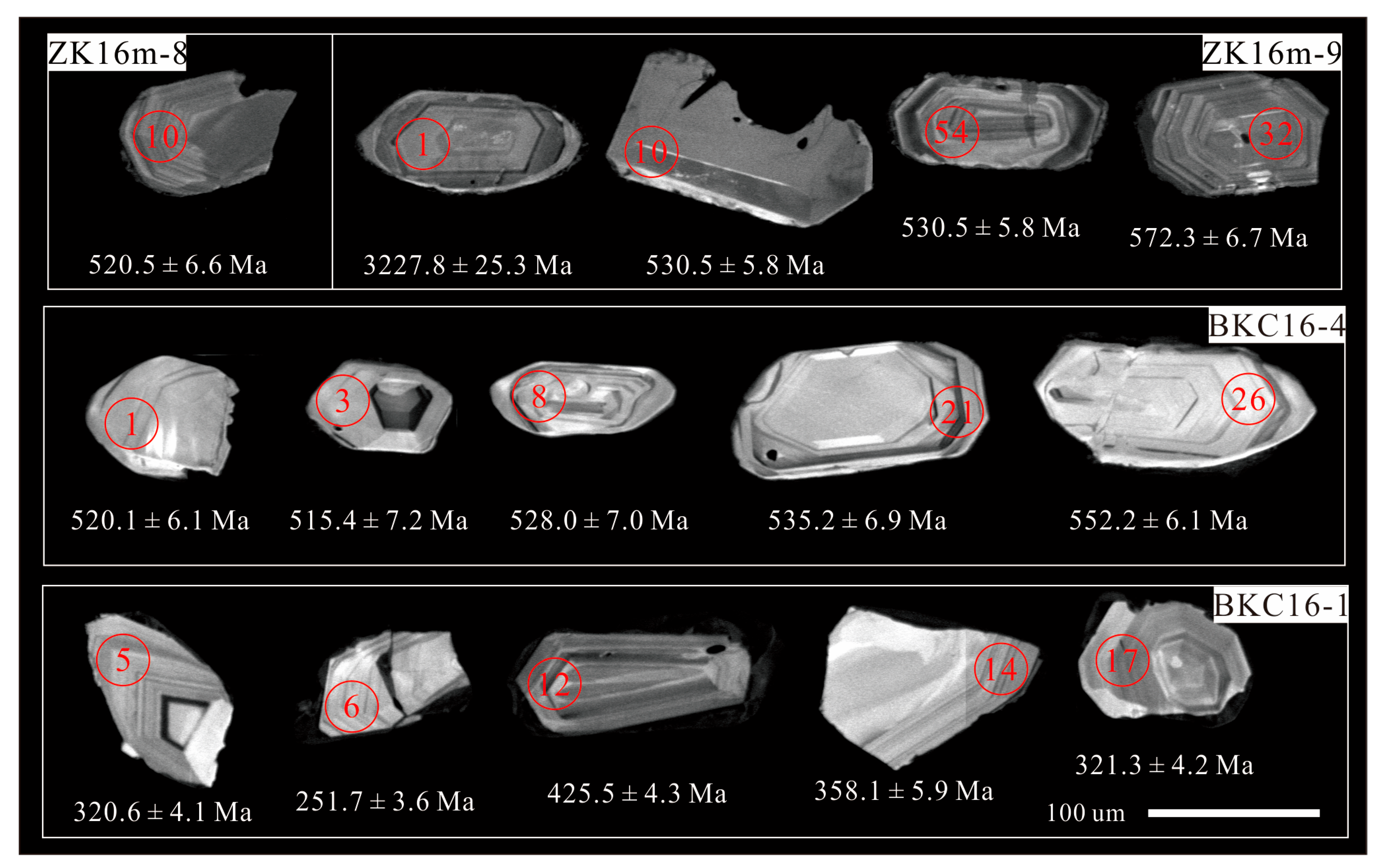
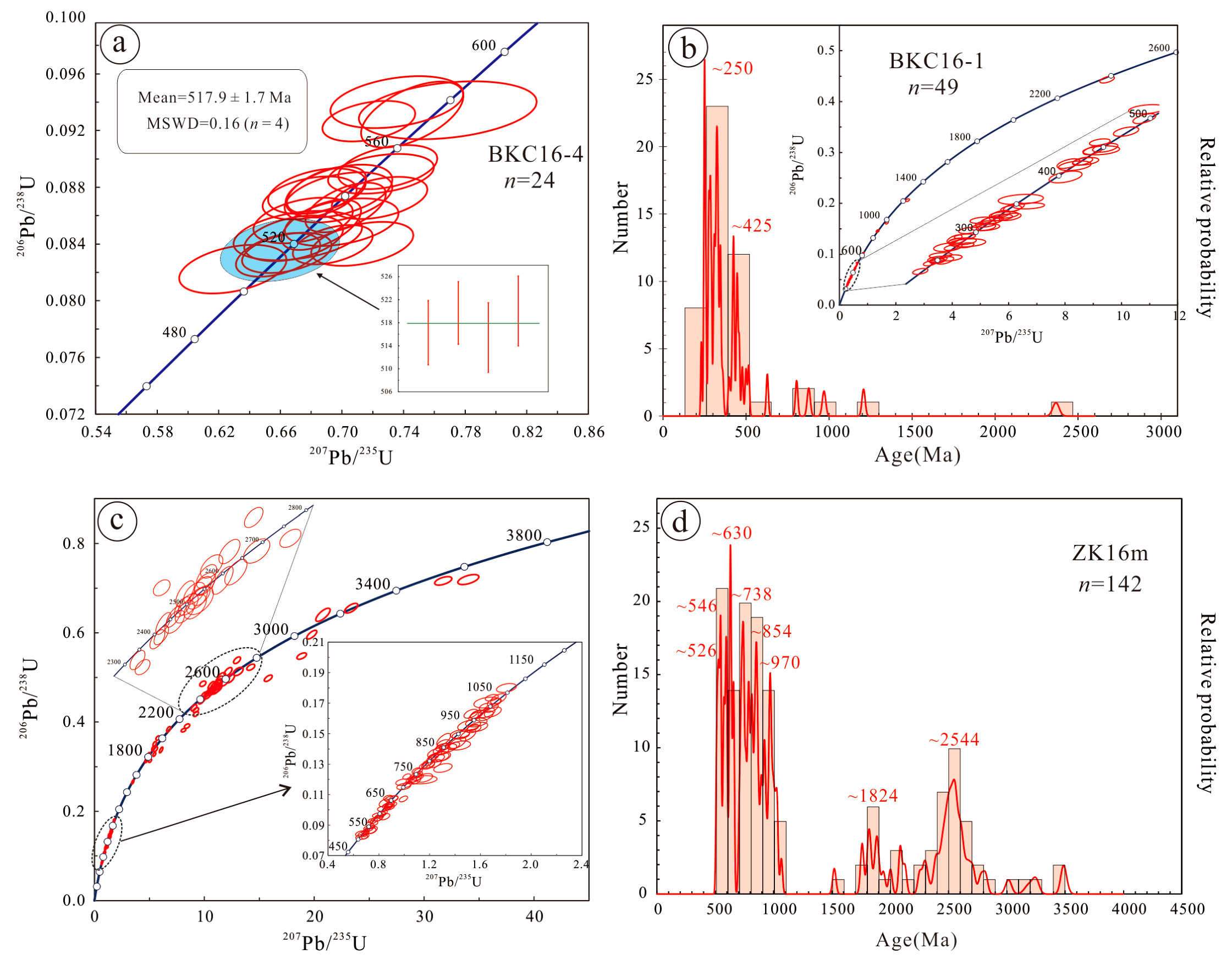
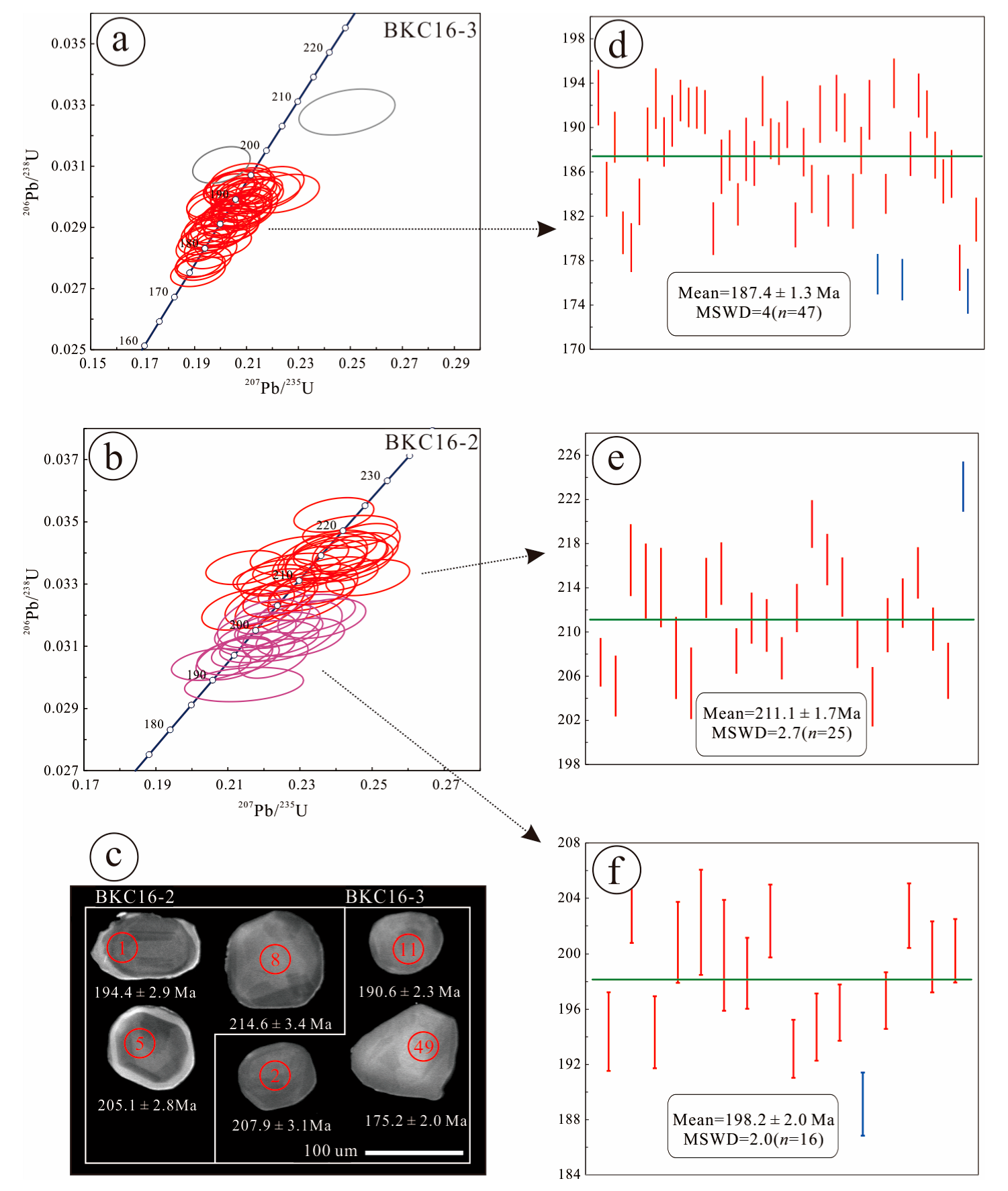
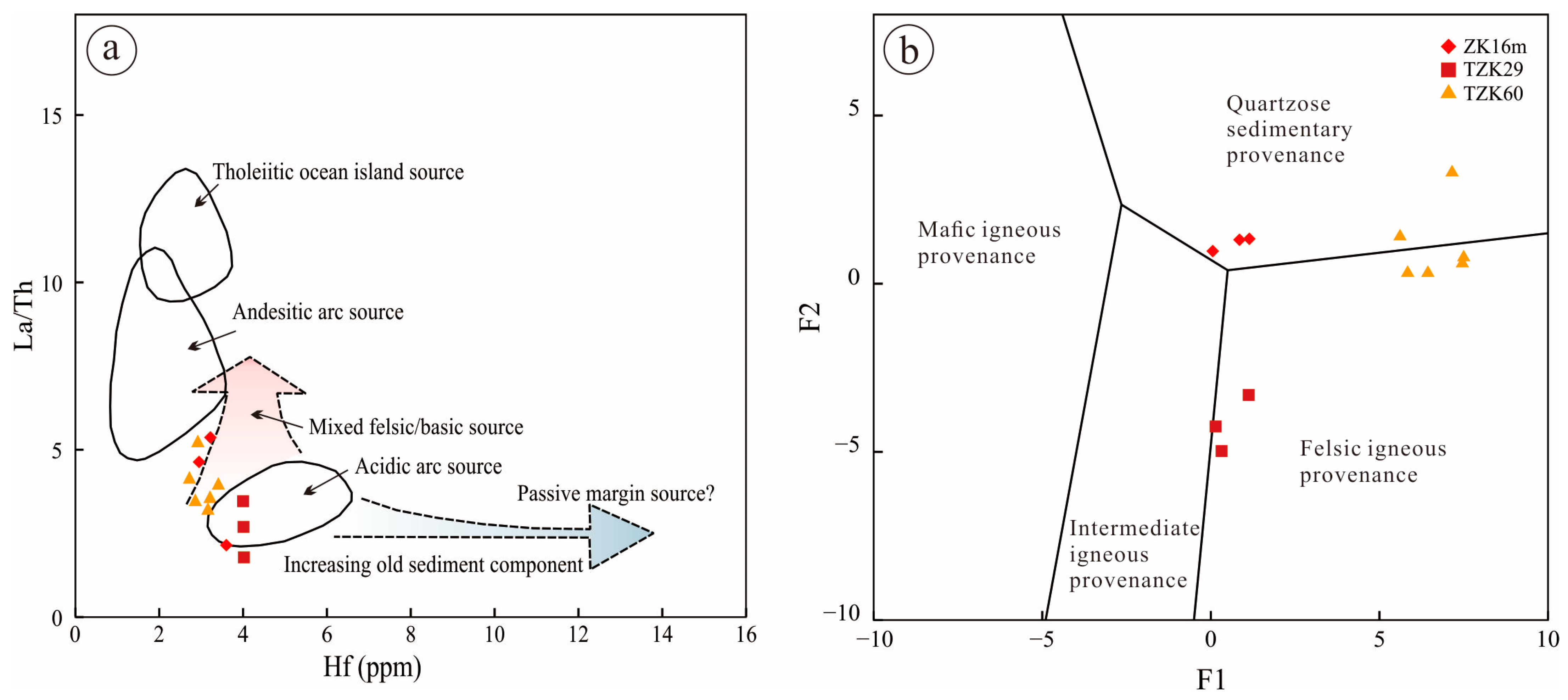
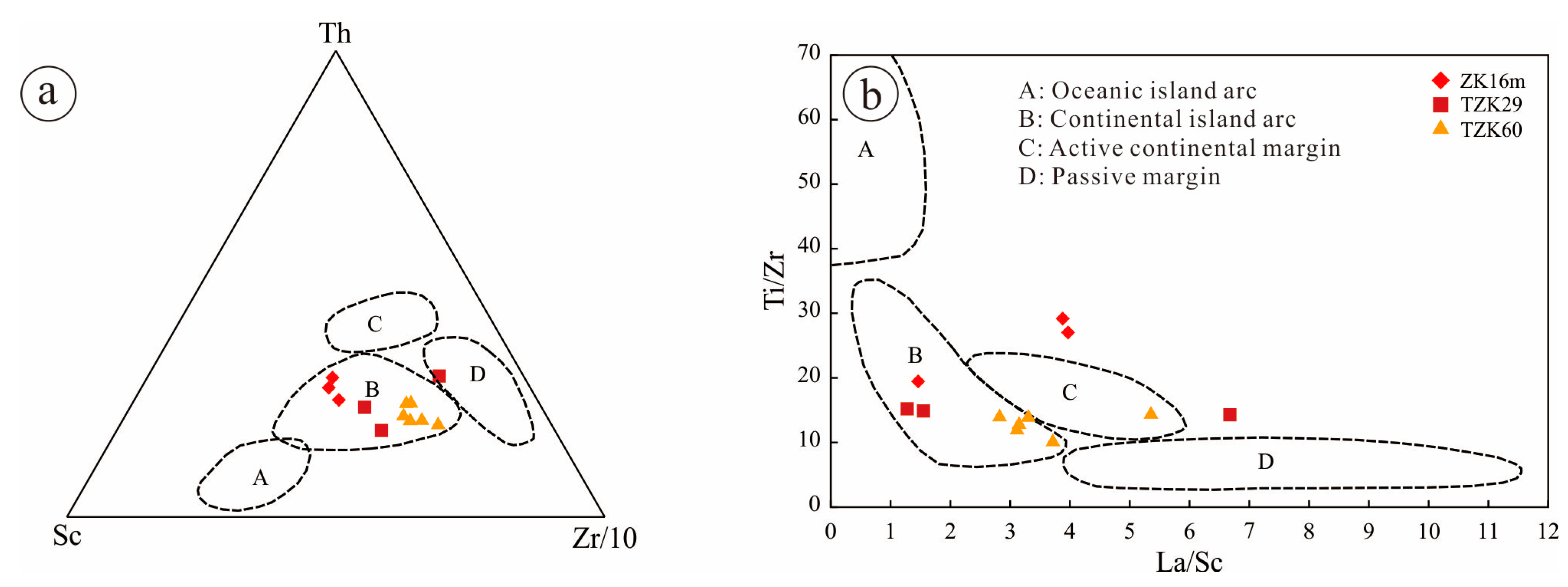
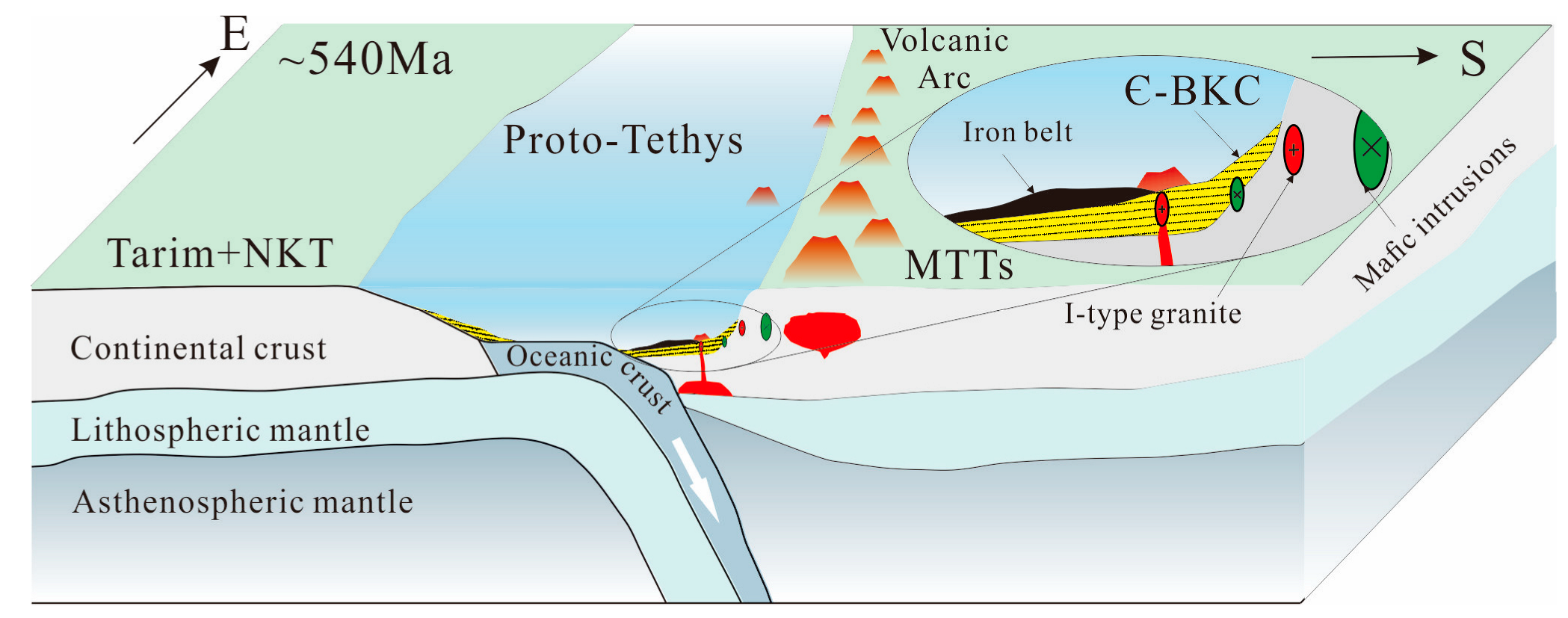
| Number | Sampling Location | Lithology | Analytical Method | Age/Ma | Age Interpretation | Data Source |
|---|---|---|---|---|---|---|
| 1 | Bulunkou | Plagioclase gneiss | LA-ICP-MS U-Pb | 1828 | Magmatic zircon | [27] |
| 2 | Bandi | Garnet-biotite schist | SHRIMP U-Pb | 2200–600 | Detrital zircon | [28] |
| 3 | East of Karachigu | Basic volcanic rock | SHRIMP U-Pb | 861 ± 43 | Magmatic zircon | [29] |
| 4 | Dabudaer | Metavolcanic | LA-ICP-MS U-Pb | 2481 ± 14 | Magmatic zircon | [30] |
| 5 | Laobing | Biotite quartzite | LA-ICP-MS U-Pb | 532 ± 3.9 | Detrital zircon | [31] |
| 6 | Laobing | Felsic schist | LA-ICP-MS U-Pb | 526 ± 5.0 | Detrital zircon | [31] |
| 7 | Bulunkou | Quartzite | LA-ICP-MS U-Pb | 515/219 | Metamorphic zircon | [32] |
| 8 | Ziluoyi | Biotite quartz schist | LA-ICP-MS U-Pb | 500 | Metamorphic zircon | [32] |
| 9 | Ziluoyi | Two-mica quartz schist | LA-ICP-MS U-Pb | 495 | Metamorphic zircon | [32] |
| 10 | Zankan | Magnetic iron ore | LA-ICP-MS U-Pb | 2465–1959 | Detrital zircon | [32] |
| 904–558 | ||||||
| 11 | Zankan | Biotite quartzite | LA-ICP-MS U-Pb | 2500 | Detrital zircon | [32] |
| 985–706 | ||||||
| 12 | Zankan | Aegirine syenite | LA-ICP-MS U-Pb | 551 | Magmatic zircon | [32] |
| 13 | Zankan | Dacite porphyry | LA-ICP-MS U-Pb | 2420–2370 | Detrital zircon | [33] |
| 800 | ||||||
| 2540 | ||||||
| 14 | Zankan | Biotite quartzite | LA-ICP-MS U-Pb | 2380 | Detrital zircon | [33] |
| 830 | ||||||
| 15 | Yelike | Biotite quartzite | LA-ICP-MS U-Pb | 565–517 | Detrital zircon | [33] |
| 16 | Yelike | Plagioclase gneiss | LA-ICP-MS U-Pb | 2600 | Detrital zircon | [33] |
| 484 | ||||||
| 17 | Taaxi | Plagioclase amphibole schist | LA-ICP-MS U-Pb | 2370 | Magmatic zircon | [33] |
| 18 | Taaxi | Meta-dacite | LA-ICP-MS U-Pb | 521 | Magmatic zircon | [34] |
| 19 | Bandi | Biotite quartzite | LA-ICP-MS U-Pb | 296 ± 2 | Magmatic zircon | [35] |
| 20 | Taaxi | Plagioclase amphibolite | LA-ICP-MS U-Pb | 516.5 ± 5.2 | Magmatic zircon | [35] |
| 21 | Yelike | Biotite quartzite | LA-ICP-MS U-Pb | 473.6 ± 7.4 | Metamorphic zircon | [35] |
| 22 | Mokaer | Plagioclase amphibole schist | LA-ICP-MS U-Pb | 511.2 ± 3.5 | Metamorphic zircon | [35] |
| 23 | Mokaer | Biotite quartzite | LA-ICP-MS U-Pb | 511.7 ± 6.7 | Metamorphic zircon | [35] |
| 24 | Zankan | Biotite quartzite | LA-ICP-MS U-Pb | 2375 ± 81 | Magmatic zircon | [36] |
| 25 | Zankan | Felsophyre | LA-ICP-MS U-Pb | 520 ± 33 | Magmatic zircon | [37] |
| 26 | Kalaizi | Bbiotite-plagioclase gneiss | LA-ICP-MS U-Pb | 537.2 ± 6.4 | Magmatic zircon | [38] |
| 27 | Laobing | Felsic gneiss | LA-ICP-MS U-Pb | 532 ± 3.9 | Detrital zircon | [39] |
| 28 | Laobing | Biotite quartzite | LA-ICP-MS U-Pb | 526 ± 5.0 | Detrital zircon | [39] |
| 29 | Bulunkou and north of Laobing | Paragneiss | LA-ICP-MS U-Pb | 580/795 (peaks) | Detrital zircon | [2] |
| 30 | 38°20′45″ N, 74°56′45″ E | Metavolcanic | LA-ICP-MS U-Pb | 508.1 ± 2.1 | Magmatic zircon | [2] |
| 37°53′05″ N, 75°16′05″ E | 515.0 ± 1.7 | |||||
| 37°53′11″ N, 75°16′01″ E | 518.8 ± 2.0 | |||||
| 31 | 37°53′11″ N, 75°16′01″ E | Gneissic intrusive rocks | LA-ICP-MS U-Pb | 510.8 ± 2.1 | Magmatic zircon | [2] |
| 37°10′25″ N, 75°36′54″ E | 513.2 ± 3.76 | |||||
| 37°08′43″ N, 75°32′03″ E | 486.1 ± 3.1 | |||||
| 37°53′01″ N, 75°16′08″ E | 245.2 ± 0.98 | |||||
| 32 | South of Laobing | Biotite plagioclase granulite | LA-ICP-MS U-Pb | 603 ± 10 | Magmatic zircon | [40] |
| 33 | Jirtiekegou | Bbiotite-quartz schist | LA-ICP-MS U-Pb | 547.4 ± 7.2 | Detrital zircon | [20] |
| 34 | Zankan | Bbiotite-quartz schist | LA-ICP-MS U-Pb | 2457–2142 | Detrital zircon | [20] |
| 1093–737 | ||||||
| 2643–542 | ||||||
| 35 | Mazar | Intermediate-acid volcanic rock | LA-ICP-MS U-Pb | 519–513 | Magmatic zircon | [41] |
| 36 | Taaxi | Amphibolite | LA-ICP-MS U-Pb | 516 ± 6 | Magmatic zircon | [42] |
| 37 | Zankan | Amphibolite | LA-ICP-MS U-Pb | 520 ± 6 | Magmatic zircon | [42] |
| 38 | Mokear | Amphibolite | LA-ICP-MS U-Pb | 516 ± 3 | Magmatic zircon | [42] |
| 39 | Mazar | Meta-rhyolites | LA-ICP-MS U-Pb | 2502.9 ± 7.4 | Magmatic zircon | [22] |
| 40 | Zankan | Meta-rhyolites | LA-ICP-MS U-Pb | 540.2 ± 2.0 | Magmatic zircon | [22] |
| 41 | Taaxi | Meta-rhyolites | LA-ICP-MS U-Pb | 540.2 ± 2.4 | Magmatic zircon | [22] |
| 530.3 ± 2.5 | ||||||
| 526.2 ± 3.3 | ||||||
| 526.2 ± 3.3 | ||||||
| 515.3 ± 2.3 | ||||||
| 515.2 ± 2.7 | ||||||
| 42 | Ziluoyi | Meta-rhyolites | LA-ICP-MS U-Pb | 526.4 ± 2.5 | Magmatic zircon | [22] |
| 516.3 ± 3.9 | ||||||
| 508.8 ± 3.6 | ||||||
| 43 | Taaxi | Metavolcanic rocks | LA-ICP-MS U-Pb | 539.3 ± 3.3 | Magmatic zircon | [21] |
| 44 | Yelike | Metavolcanic rocks | LA-ICP-MS U-Pb | 543.7 ± 5.7 | Magmatic zircon | [21] |
| 45 | Yelike | Meta-greywacke | LA-ICP-MS U-Pb | 535.9 ± 5.1 | Detrital zircon | [21] |
| 46 | Kalaizi | Meta-arkose rock | LA-ICP-MS U-Pb | 539.7 ± 3.3 | Detrital zircon | [21] |
| Sample | Location | Structure | Texture | Lithology | Mineral Assemblage |
|---|---|---|---|---|---|
| BKC16-1 | 37°33′3.366″ N 75°39′41.874″ E | gneissic | medium coarse grain lepidoblastic | Sillimanite-biotite gneiss | sillimanite (~5%), garnet (~5%), biotite (20%), muscovite (~5%), quartz (~60%), and plagioclase (~5%) |
| BKC16-2 | 37°30′7.092″ N 75°39′52.884″ E | gneissic | medium to coarse granular-sheet | Garnet-biotite feldspar granulite | garnet (~20%), alkalifeldspar (~20%), plagioclase (~30%), biotite (~10%), amphibole (~10%), quartz (~5%), stilpnomelanite (~5%) |
| BKC16-3 | 37°27′11.508″ N 75°39′25.626″ E | schistose | fine to medium granular-sheet | Bbiotite-amphibole feldspar schist | Plagioclase (~40%), amphibole (~45%), biotite (~10%), quartz (~5%) |
| BKC16-4 | 37°22′38.484″ N 75°40′51.276″ E | massive | homoeoblastic | Plagioclase-amphibolite granulit | Plagioclase (~45%), amphibole (~40%), biotite (~5%), quartz (~10%) |
| ZK16 | Zankan iron deposit | massive | granular | Iron ore | Magnetite (~60%), pyrite(~25%),diopside(~10%), apatite, feldspar et al.(~5%) |
| ZK16m-3 | 37°15′2.508″ N 75°37′37.446″ E | schistose | fine grain lepidoblastic | Garnet-biotite amphibole quartz schist | garnet (~10%), biotite (~10%), quartz (~50%), feldspar (~10%), amphibole (mostly anthophyllite~20%), sulfide minerainornor) |
| ZK16m-8 | |||||
| ZK16m-9 |
Disclaimer/Publisher’s Note: The statements, opinions and data contained in all publications are solely those of the individual author(s) and contributor(s) and not of MDPI and/or the editor(s). MDPI and/or the editor(s) disclaim responsibility for any injury to people or property resulting from any ideas, methods, instructions or products referred to in the content. |
© 2023 by the authors. Licensee MDPI, Basel, Switzerland. This article is an open access article distributed under the terms and conditions of the Creative Commons Attribution (CC BY) license (https://creativecommons.org/licenses/by/4.0/).
Share and Cite
Ding, M.; Li, Q.; Tang, H.; Zhang, J. The Redefinition of the “Bulunkuole Group” in the West Kunlun Orogenic Belt, Xinjiang (NW China): Implications for Tectonic Evolution of the Proto-Tethys. Minerals 2023, 13, 776. https://doi.org/10.3390/min13060776
Ding M, Li Q, Tang H, Zhang J. The Redefinition of the “Bulunkuole Group” in the West Kunlun Orogenic Belt, Xinjiang (NW China): Implications for Tectonic Evolution of the Proto-Tethys. Minerals. 2023; 13(6):776. https://doi.org/10.3390/min13060776
Chicago/Turabian StyleDing, Mingpeng, Qiugen Li, Haoshu Tang, and Jing Zhang. 2023. "The Redefinition of the “Bulunkuole Group” in the West Kunlun Orogenic Belt, Xinjiang (NW China): Implications for Tectonic Evolution of the Proto-Tethys" Minerals 13, no. 6: 776. https://doi.org/10.3390/min13060776
APA StyleDing, M., Li, Q., Tang, H., & Zhang, J. (2023). The Redefinition of the “Bulunkuole Group” in the West Kunlun Orogenic Belt, Xinjiang (NW China): Implications for Tectonic Evolution of the Proto-Tethys. Minerals, 13(6), 776. https://doi.org/10.3390/min13060776





